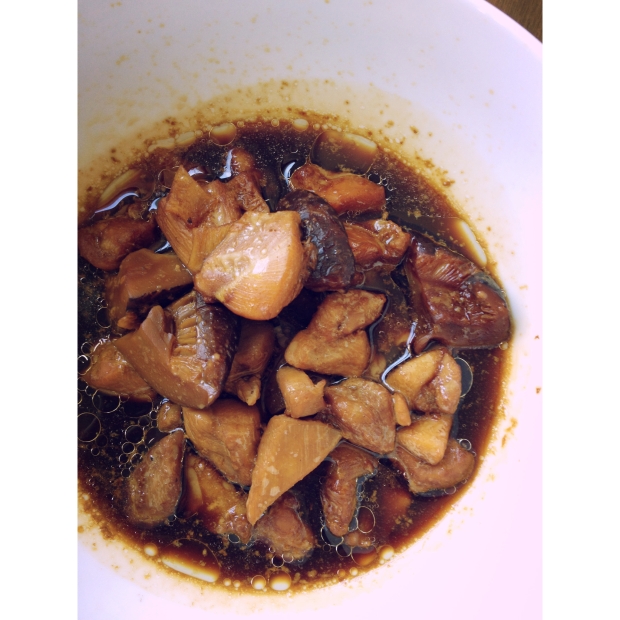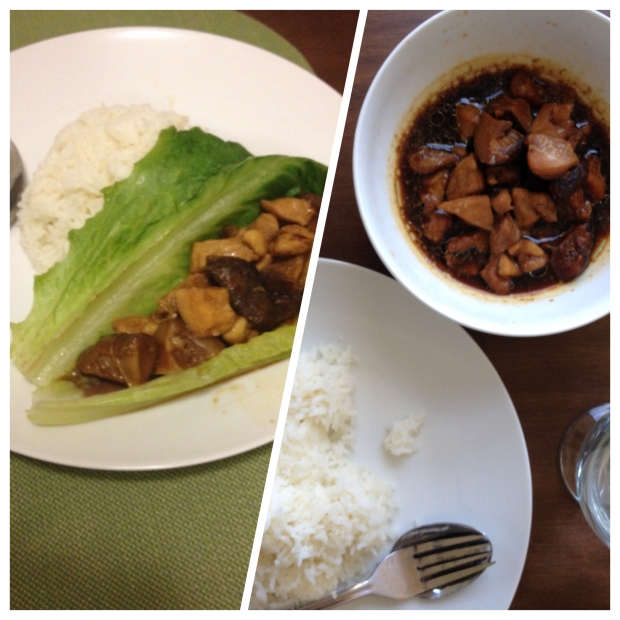I’ve often fantasized about making this Comforting Chicken and Shittake Mushroom Stew whenever I craved for a simple meal with lots of gravy . Finally I cooked this dish in an attempt to make the a nice meal for W last week when he was ill with a bad cold.
The stew turned out to be right up our taste alley. It was even better the next day for lunch – loved the mushrooms. A little on the oily side (I wasn’t as thorough in trimming the chicken fat as I could have been), but very satisfying with Thai white rice.
I’ve approximated the measurements here but I’m afraid my recipe is not tried and tested at all. Still, wanted to share.
Comforting Chicken and Shittake Mushroom Stew // Served two ways here
Ingredients:
400 grams chicken thighs, in bite-sized pieces
6-8 x dried Shittake mushrooms, soaked in warm water so that they are reconstituted and soft (remove stalks)
2x cloves garlic, minced finely
a small section of ginger (I use about 4 cm squared), finely sliced into little matchsticks
vegetable oil, 1 tablespoon
salt
for the sauce:
light soy sauce, 1.5 tablespoons
dark soy sauce, 1.5 tablespoons
oyster sauce, 1 tablespoon
rice wine/Shaoxing wine/sherry, 0.5 tablespoon
water, one-third cup
ground white pepper, a few dashes
Method:
0. Soak Shittake mushrooms in warm water. This is done preferably a few hours before cooking but if in a rush, use boiling water and half an hour should do it. Slice each mushroom into 4 wedge pieces.
1. Chop chicken thighs into bite-sized pieces, removing excess skin and fat. Marinate with salt.
2. Heat wok on low-medium heat. Add oil.
3. When oil is hot, stir-fry garlic and ginger until fragrant.
4. Add chicken to wok, stir-fry.
5. When chicken is slightly browned on outside (not completely cooked inside though), add mushrooms.
6. Mix mushrooms and chicken.
7. Mix ingredients for the sauce in bowl. Add to wok.
8. Cover wok with lid. Once mixture has come to a boil, turn heat down to low so that it is just simmering.
9. Let simmer on low heat for at least half an hour.
10. Make sure that there is enough liquid to just barely cover the protein. Add water 1 tablespoon at a time if necessary.
11. Taste stew and add salt to taste.
12. You’re done!
When making this last week, I added a few large Romaine lettuce leaves to the wok to steam them for 2 minutes before switching off the heat. I then ladled the stew on top of the lettuce. It was an easy way of getting some green in our meal without having to prepare a side.
In my college days, I used to make a version of this with small chunks of potato – also yummy but the starch in the potato would make the sauce very thick. I refer this version for its relative simplicity.
Enjoy!


